Ngoc Son Temple, known as the Temple of the Jade Mountain, is nestled on Jade Island in the tranquil waters of Hoan Kiem Lake in Hanoi, Vietnam. The temple is not just a religious site; it’s an emblem of Vietnamese heritage, symbolizing the country’s rich past and cultural significance. Walking into Ngoc Son Temple feels like stepping back in time to a place where history, spirituality, and culture converge.
This sacred site was built in the early 19th century during the reign of the Nguyen Dynasty, but historical records suggest the presence of earlier structures dating as far back as the 17th century. The temple honors General Trần Hưng Đạo, a venerated military leader, along with Van Xuong De Quan, a deity linked to literature and education.
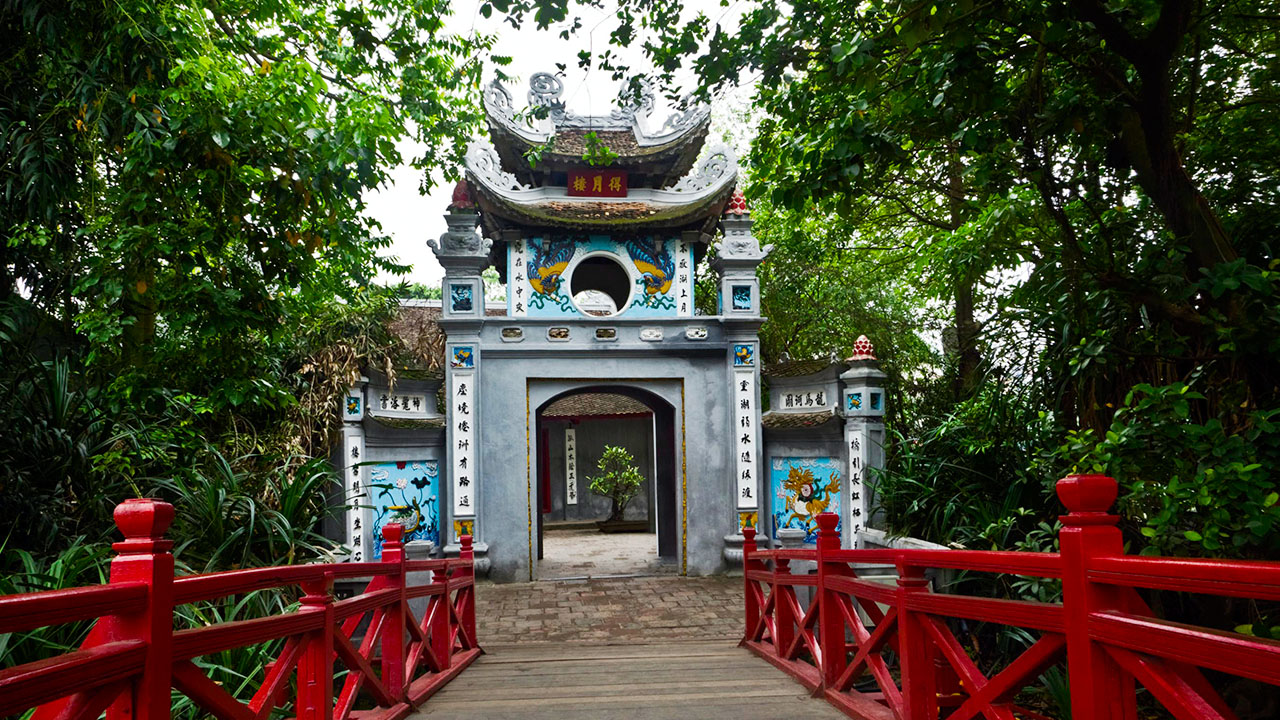
Ngoc Son Temple is more than just an architectural marvel. It’s a sanctuary where legends come to life, and each corner of the temple tells a story woven into the fabric of Vietnamese folklore. The temple’s unique fusion of Vietnamese and Chinese architectural elements mirrors the cultural interactions between the two civilizations over centuries.
Visitors can marvel at the iconic Huc Bridge, the Pen Tower, and the pavilion structures, all of which add to the site’s spiritual ambiance. Declared a National Special Relic Site in 2013, Ngoc Son Temple stands as a testament to Vietnam’s historical resilience and cultural pride. For anyone seeking a deeper understanding of Vietnam’s history and heritage, a visit to Ngoc Son Temple is an absolute must.
History of Ngoc Son Temple Hanoi
The historical tapestry of Ngoc Son Temple is enriched with narratives that are both captivating and deeply moving. This temple has witnessed eras of transformation, which have shaped its current form and significance. Originally constructed in 1841 during the early period of the Nguyen Dynasty, it is believed that even before this, it served as a sacred site dating back to the 17th century. Some historians draw parallels between Ngoc Son Temple and ancient temples found in China, hinting at shared architectural traits and historical interactions that have influenced its design.
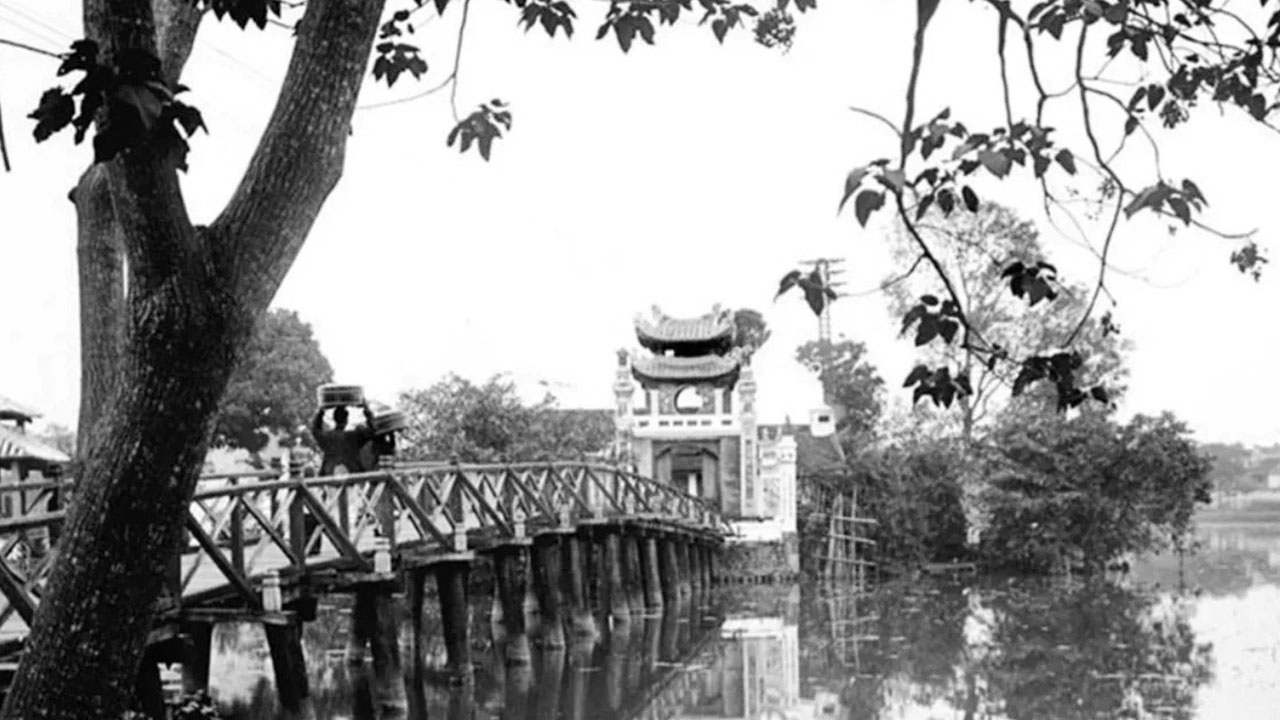
The temple pays homage to General Trần Hưng Đạo, whose successful campaigns against the Mongol invasions during the 13th century have earned him a legendary status in Vietnamese history. His legacy intertwines with Ngoc Son Temple’s identity, creating a monument that exemplifies bravery and wisdom. Additionally, Van Xuong De Quan is worshipped here, reflecting the nation’s profound respect for education and literary pursuits. This unique combination of honoring both a military leader and a deity of literature encapsulates the harmony between martial valor and intellectual aspirations in Vietnamese culture.
In 2013, the Vietnamese government recognized Ngoc Son Temple as a National Special Relic Site, emphasizing its cultural and historical importance. This recognition not only preserves the physical structure but also safeguards the narratives that it embodies. The continuous reverence for the temple through the ages signifies its enduring relevance in embodying Vietnamese spirit and pride. By exploring the history of Ngoc Son Temple, one can truly grasp the essence of Vietnam’s journey through the annals of time, witnessing the confluence of history, spirituality, and culture that shapes the nation’s identity.
Construction and Renovations
When we speak of Ngoc Son Temple, we delve into a chronology marked by meticulous construction and thoughtful renovations that have ensured its endurance through the years. The temple’s original construction in 1841 was overseen by various prominent figures of the Nguyen Dynasty, marking a period of architectural innovation and cultural renaissance. Historical anecdotes liken the construction process to the careful weaving of a tapestry, where each thread holds significance and purpose.
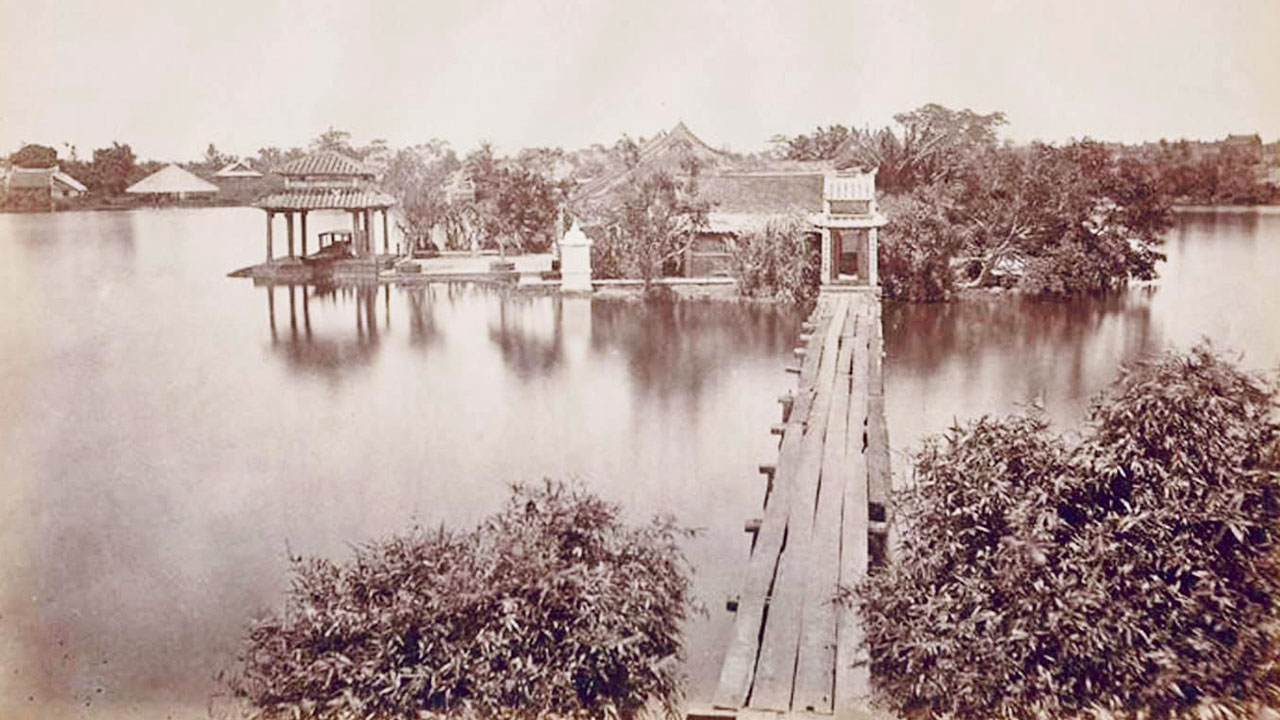
The initial structure of Ngoc Son Temple was relatively modest compared to its present grandeur. Renovations in 1865, led by the famed scholar Nguyen Van Sieu, brought transformative changes. Nguyen Van Sieu, often heralded as the “Culture Protector,” is compared to a gardener nurturing a rare plant, enriching the temple with additional structures and aesthetic embellishments. His contributions included the Huc Bridge, the Pen Tower, and the Tran Ba Pavilion, turning Ngoc Son into a sprawling complex that seamlessly blended functionality with ornate beauty.
To understand the depth of these renovations, consider this comparison:
| Element | Pre-1865 Structure | Post-1865 Renovation |
|---|---|---|
| Huc Bridge (Thê Húc) | Simple wooden construction connecting the island to the mainland | Iconic red-painted bridge with intricate dragon carvings, symbolizing spiritual transition |
| Pen Tower (Tháp Bút) | Absent | 28-meter tall tower signifying academic achievement, topped with a stone feather pen |
| Tran Ba Pavilion | Basic open-air structure | Enhanced with detailed columns, serving as a cultural shield against negative influences |
These renovations were more than mere structural enhancements; they were a reclamation and celebration of Vietnamese culture and identity. Nguyen Van Sieu’s vision ensured that Ngoc Son Temple would not only withstand the physical tests of time but also remain a spiritual and cultural stronghold for future generations.
Visiting Ngoc Son today, the comparative tranquility and beauty of the temple juxtapose the bustling modernization of Hanoi, serving as a serene reminder of the city’s rich history. The continued maintenance and occasional refurbishments speak volumes about the dedication to preserving this emblematic site, ensuring it remains a haven of spirituality and cultural pride. Every inch of the temple, from the revered Huc Bridge to the towering Pen Tower, resonates with a narrative of resilience and reverence, making Ngoc Son Temple not just a tourist spot but a pilgrimage for understanding the soul of Vietnam.
Legends Associated with the Temple
Ngoc Son Temple holds within its sacred grounds a treasure trove of legends, each illustrating unique facets of Vietnamese culture and spirituality. The most captivating story is undoubtedly the Legend of the Turtle and the Mystical Sword, a tale akin to the Arthurian legend of the Sword in the Stone, deeply rooted in the collective consciousness of the Vietnamese people.
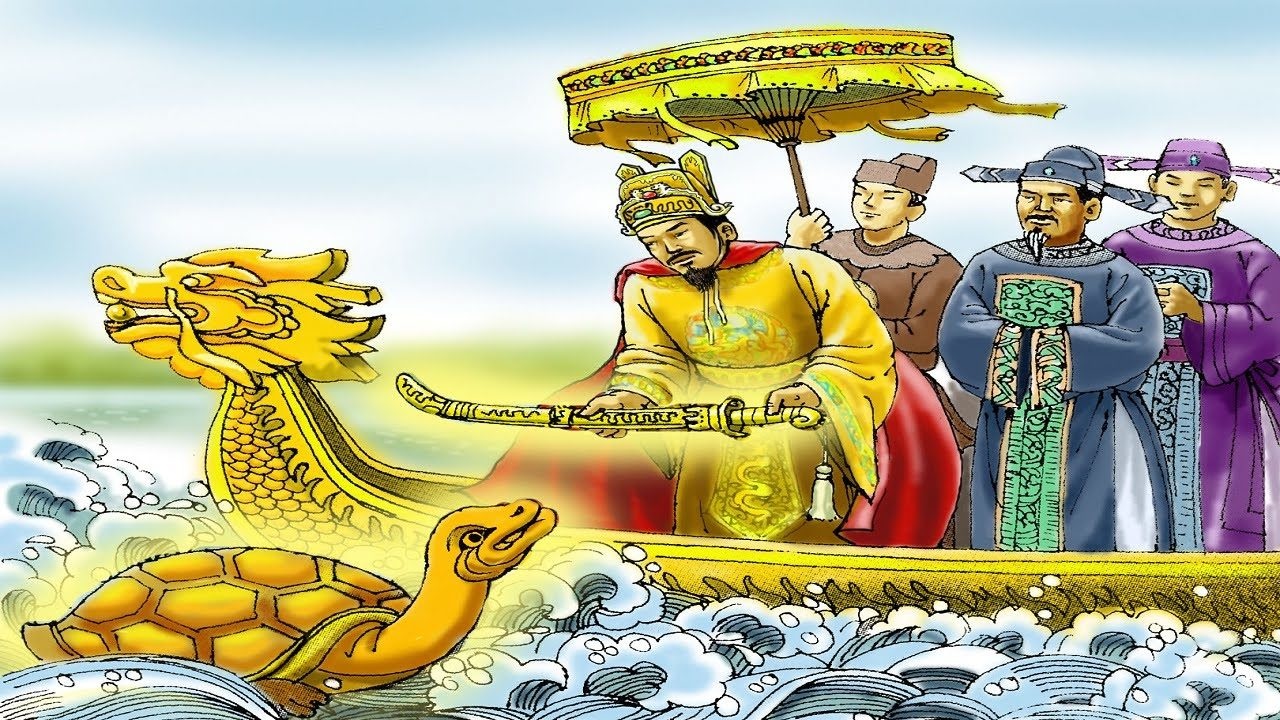
According to this legend, Emperor Lê Lợi found himself blessed with an enchanted sword given by the Golden Turtle God. With this divine weapon, he successfully repelled the Chinese invaders, much like a knight wielding his trusty sword against insurmountable odds. Upon securing victory, the emperor returned the sword to the Turtle in Hoan Kiem Lake, which today remains a powerful symbol of national resilience and unity against oppression. The lake itself is often compared to a mirror, reflecting the profound bond between Vietnam’s past and present at its serene surface.
Ngoc Son Temple is also steeped in the legacy of General Trần Hưng Đạo, whose spirit is venerated here. Historical records liken his military strategies and indomitable spirit to those of Sun Tzu, emphasizing wisdom intertwined with martial prowess. The temple serves as a spiritual conduit, linking contemporary Vietnamese society to the valorous heritage of their ancestors, exemplified by General Trần Hưng Đạo’s life and legacy.
Adding another layer to its mystical ambiance is the legend of the Three Sages originally worshipped at the temple. The trio consisted of Wenchang Dijun, the deity of literature; Guan Yu, the embodiment of loyalty and valor; and Lü Dongbin, revered for wisdom and immortality. As the temple evolved, this triad was replaced by a focus on Trần Hưng Đạo, reflecting a shift towards honoring national heroes over mythological figures, much like the way societies adapt their myths to reflect contemporary values.
These legends are meticulously woven into the very fabric of Ngoc Son Temple through its architectural elements and spiritual practices. Visitors often find themselves caught in a time-warp, where every step taken feels like a recitation of ancient Vietnamese folklore. The constant presence of local worshippers alongside curious tourists creates a perfect amalgamation of reverence and learning, mirroring the legends’ ability to transcend time and space.
Through the lens of these legends, Ngoc Son Temple transcends its physical form, standing as a testament to Vietnam’s rich cultural tapestry. Much like the enchanting allure of Epidaurus in ancient Greece, Ngoc Son captivates not just through its architectural brilliance but through the enduring legends that breathe life into its stones. It is within these stories that visitors uncover the essence of Vietnamese identity, finding parallels between the mythical and the historical that form the backbone of this awe-inspiring temple.
Architectural Features
Ngoc Son Temple is an epitome of architectural elegance and spiritual symbolism, masterfully blending Vietnamese and Chinese design elements. Each feature of the temple speaks volumes about the nation’s rich cultural heritage and artistic prowess. The structural beauty of Ngoc Son Temple stands as a testament to Vietnam’s architectural ingenuity.
The Huc Bridge
The Huc Bridge, also known as Thê Húc Bridge, serves as the gateway to Ngoc Son Temple and is perhaps its most iconic feature. This vibrant red wooden bridge appears as a stroke of bold brushwork amidst the serene canvas of Hoan Kiem Lake, symbolizing a poetic union of the tangible and the ethereal. Its name, meaning “where the light of the morning sun is reflected,” evokes images of the first light touching an artist’s palette, heralding a new day.
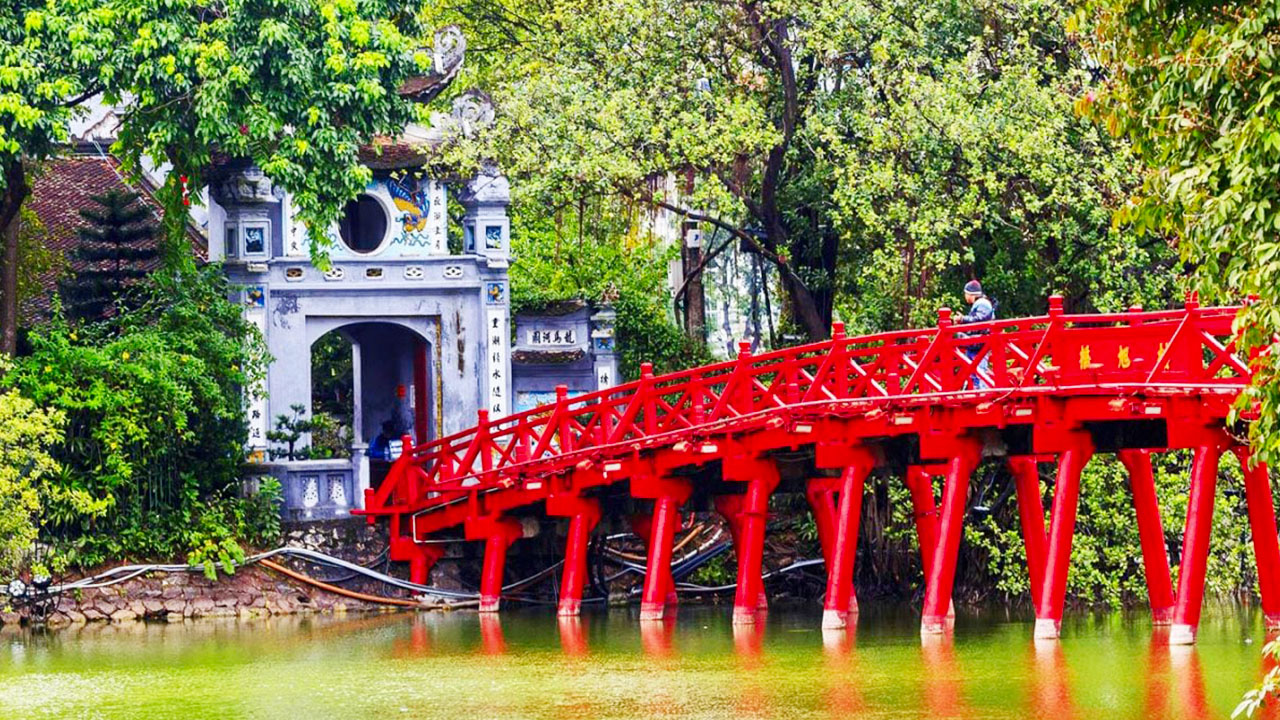
Built in the 19th century under the supervision of Nguyen Van Sieu, the bridge’s architectural style is a harmonious blend of Vietnamese and Chinese influences. It was initially constructed with 32 wooden pillars supporting 15 spans, embodying a combination of grace and sturdiness. Over the centuries, renovations have reinforced its structural integrity, with major updates in 1897 and further in 1952, replacing parts of the wooden structure with concrete while preserving its original aesthetic essence.
The charm of the Huc Bridge lies in its symbolism and design. Painted in a brilliant vermilion red, a color deeply significant in Vietnamese culture for its associations with luck and prosperity, the bridge stands out vividly against the tranquil, green waters of Hoan Kiem Lake. This striking contrast is akin to a phoenix rising from its ashes, symbolizing rebirth and perennial beauty. Ornate carvings of dragons and clouds along the handrails encapsulate traditional artistic motifs, weaving an intricate tapestry of mythology and reverence.
Crossing the Huc Bridge is an experience akin to traversing from the mundane to the sacred. It serves as a metaphorical pathway, not just a physical one, marking the transition from the hustle and bustle of Hanoi’s city life to the serene spiritual haven of Ngoc Son Temple. The bridge’s aesthetic appeal and symbolic significance make it a popular subject for photographers and artists alike, who often capture its enchanting beauty during early mornings and twilight, when the interplay of light and shadow enhances its mystique.
The Huc Bridge’s role extends beyond mere functionality; it embodies a blend of architectural brilliance and spiritual symbolism. Its meticulous design and vibrant history resonate with every visitor who steps onto its wooden planks, reflecting the soul of Ngoc Son Temple and the cultural heartbeat of Vietnam.
The Pen Tower and the Ink Slab
Positioned magnificently within the Ngoc Son Temple complex, The Pen Tower (Tháp Bút) and The Ink Slab (Đài Nghiên) offer a unique blend of educational and philosophical symbolism that stands tall, much like a scholar reaching for the heavens. Together, they form an architecturally and culturally profound duo within the temple grounds.
The Pen Tower, rising to an imposing height of 28 meters, is designed to resemble a stone feather pen. This structure stands on a hill of stones, symbolizing the heights of academic and intellectual achievement. The phrase “Ta Thanh Thien” inscribed on the tower translates to “Write onto the sky,” directly alluding to scholarly pursuits that aim to achieve greatness. This symbolism is further amplified by the sight of the pen’s nib, pointing skywards as if eternally inscribing thoughts and ideas into the celestial canvas. It represents Vietnam’s rich literary heritage and the profound respect for knowledge and education that permeates Vietnamese culture.
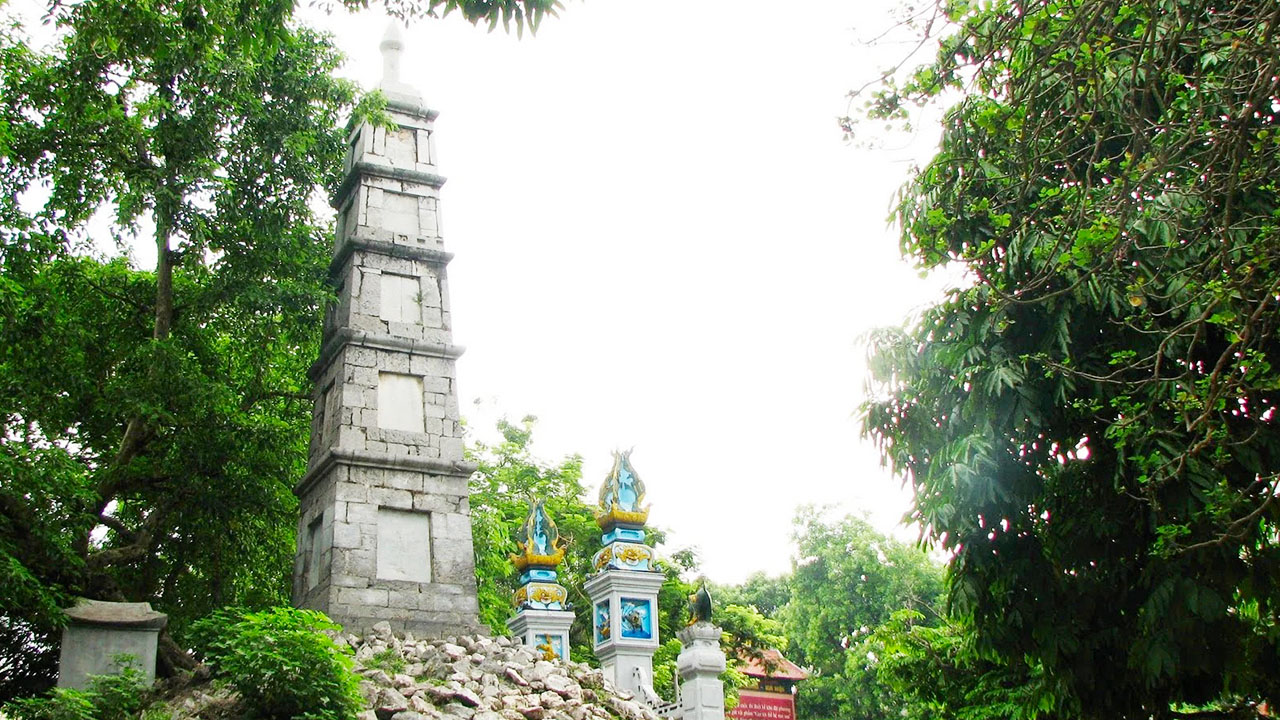
Adjacent to The Pen Tower is The Ink Slab, an integral part of this scholarly emblem. Crafted from blue stone and supported by three toad-like structures, The Ink Slab reinforces the connection between writing and the divine. Positioned in proximity to Dai Nghien Gate, it completes the narrative of intellectual pursuits, groundings aspirations with practicality. Nguyen Van Sieu’s poem, inscribed on the slab, adds historical and literary weight to the structure, much like how ancient stone tablets bore the decrees of emperors and sages.
The relationship between The Pen Tower and The Ink Slab mirrors the synergy between ambition and wisdom, aspiration and reflection. It is akin to the harmonious balance found in a well-composed symphony, where each note contributes to the overall melody. The shadow of The Pen Tower falling upon The Ink Slab on specific lunar days transforms it into a sacred ritual, infusing the site with an aura of mysticism and reverence. This phenomenon is similar to the way ancient astrologers used celestial events to symbolize divine connections and earthly manifestations.
Visually and philosophically, these structures enhance the Ngoc Son Temple’s narrative, reflecting the significance placed on education and intellectual achievements. Their design and symbolism make them not mere ornamental additions but integral components of the temple’s cultural and spiritual essence. The Pen Tower and The Ink Slab together elevate the temple’s stature, mirroring Vietnam’s dedication to preserving and celebrating its scholarly and cultural heritage. Each visitor’s gaze upon The Pen Tower and The Ink Slab is a reminder of the endless potential of human intellect and the enduring value of wisdom throughout the ages.
Pavilion Structures Within the Temple Complex
Ngoc Son Temple’s complex is adorned with numerous pavilion structures that are architecturally significant and culturally resonant. These pavilions contribute to the temple’s spiritual ambiance and stand as symbols of Vietnam’s architectural mastery.
Tháp Bút (Pen Tower): This structure encapsulates the temple’s intellectual spirit. Rising 28 meters and topped with a stone feather pen, it symbolically reaches towards the heavens, emphasizing academic achievement and literary pursuits in Vietnamese culture. The Pen Tower’s architectural design and inscriptions like “Ta Thanh Thien” reflect the influence of the Trinh Lords in Vietnam’s literary and defensive history, creating a blend of cultural and scholarly symbolism.
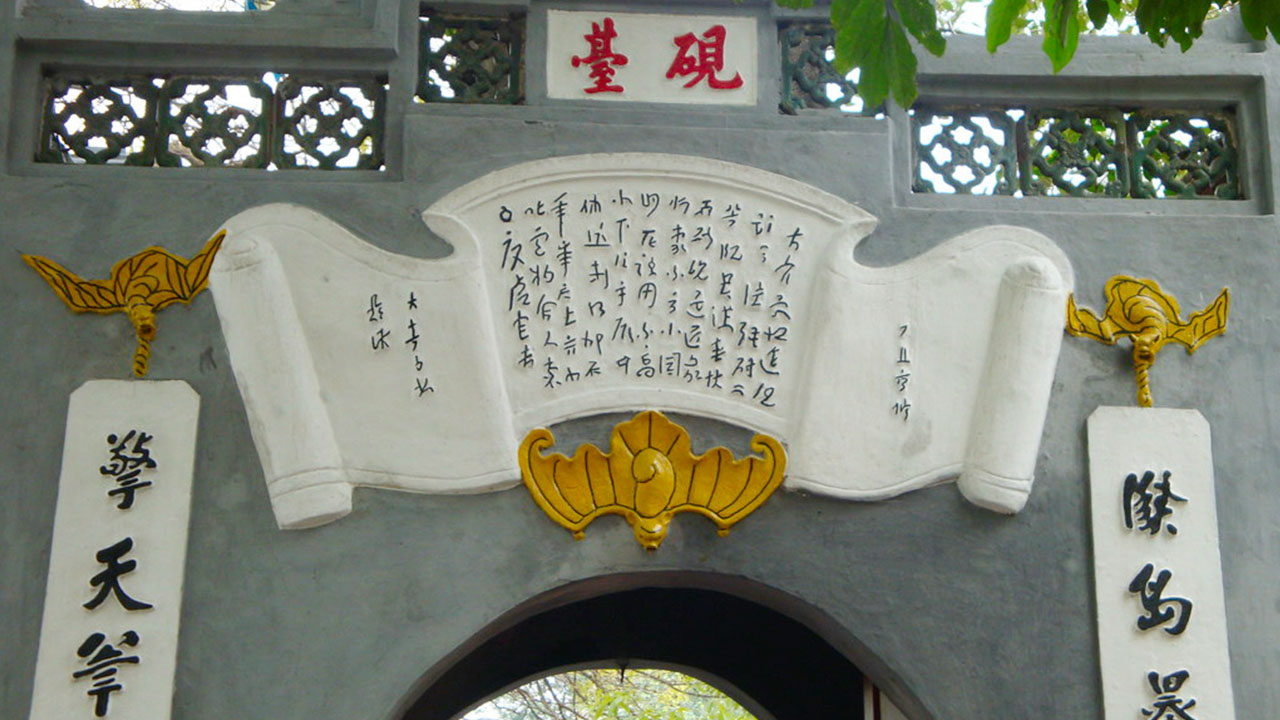
Đài Nghiên (Ink Slab): Near the Dai Nghien Gate, this intriguing structure comprises three toad-like stones supporting a blue stone inkpot. It features a poem by Nguyen Van Sieu, adding layers of historical significance. The lore states that on the fifth day of the fifth lunar month, the feather pen’s shadow falls upon the inkpot, symbolizing the divine connection between writing and celestial forces. This phenomenon highlights the structure’s enigmatic allure and its importance within the temple.
Đắc Nguyệt (Moon Gazing Pavilion): Located at the temple’s entrance, this pavilion boasts dual-layered roofs and intricate dragon and phoenix imagery on its windows, symbolizing harmony and balance. It’s a space for tranquil contemplation, embodying the virtues of strength and resilience. The pavilion’s design reflects traditional aesthetics, creating a serene environment for visitors.
Trấn Ba Đình (Tidal Wave Defense Pavilion): Serving as a cultural defense against external influences, this open-air pavilion emphasizes stability and endurance through its intricate column work and design. It stands as a fortress against cultural invasions, reflecting Vietnam’s historical resistance to foreign domination. Its aesthetic appeal and symbolism make it a crucial part of the temple’s architectural narrative.
The Huc Bridge: Although typically considered more of a connecting pathway, The Huc Bridge is integral to the temple complex. Its iconic red color, symbolizing good luck and prosperity, sets it apart as a spiritual threshold between the city and the sacred temple grounds. The bridge acts as a conduit for visitors, blending natural beauty with architectural elegance.
These pavilion structures within the Ngoc Son Temple complex represent more than architectural feats. They embody Vietnam’s cultural identity, showcasing elements of Confucianism and Taoism, symbolizing knowledge, harmony, and resilience. Each pavilion resonates with historical narratives and artistic values, creating a tapestry of spiritual and cultural heritage that enriches visitors’ experiences.
Cultural Significance
Ngoc Son Temple stands as a beacon of Vietnam’s cultural and historical identity, resonating deeply with visitors through a potent blend of spiritual and national pride. This temple reflects the country’s respect for heroic deeds, educational excellence, and its rich tapestry of folklore. It serves not only as a place of worship but also as a cultural keystone that embodies the enduring spirit and values of the Vietnamese people. The deities venerated at Ngoc Son Temple and its representation in folklore highlight its cultural significance, offering profound insights into the nation’s identity and legacy.
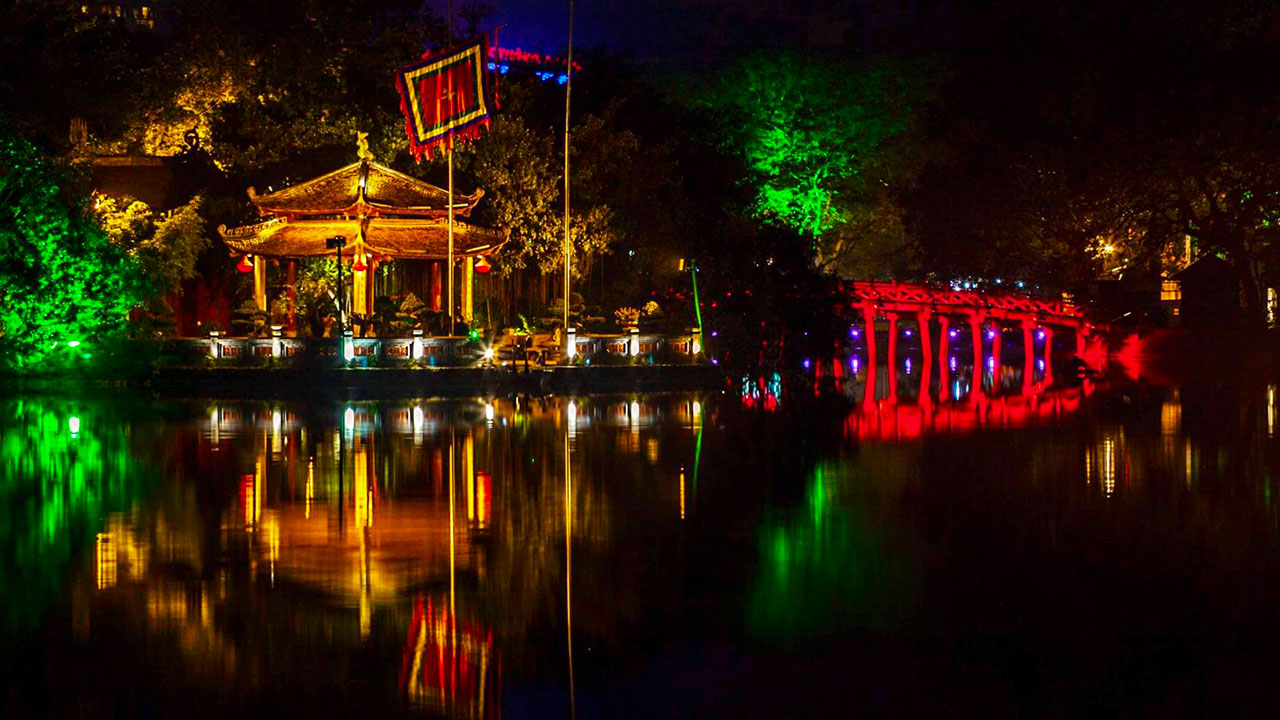
Deities Worshipped at Ngoc Son Temple
Ngoc Son Temple harbors a spiritual richness that is both unique and deeply interwoven with Vietnamese culture. Chief among the deities venerated here are Trần Hưng Đạo and Văn Xương Đế Quân, figures who epitomize the dual pursuit of martial valor and intellectual excellence.
Trần Hưng Đạo: Revered as one of Vietnam’s greatest military heroes, Trần Hưng Đạo’s legacy is immortalized within Ngoc Son Temple. His successful campaigns against the Mongol invasions in the 13th century are akin to David fending off Goliath, showcasing resilience and strategic brilliance against overwhelming odds. Trần Hưng Đạo’s spiritual presence at Ngoc Son underscores a fierce national pride and serves as an eternal symbol of Vietnam’s fight for sovereignty and independence.
Văn Xương Đế Quân: Known as the deity of literature and education in Taoist belief, Văn Xương Đế Quân is worshipped for his association with scholarly wisdom and intellectual pursuit. The veneration of this deity at Ngoc Son Temple reflects a profound cultural reverence for education and knowledge, akin to the Greeks honoring Athena as the goddess of wisdom. This veneration highlights the balance of intellectual and martial prowess as both are seen as foundational pillars of Vietnamese society.
The dual worship of Trần Hưng Đạo and Văn Xương Đế Quân creates a rich tapestry of cultural symbolism within the temple. This reverence encapsulates essential components of Vietnamese identity – resilience in the face of adversity and an unwavering pursuit of knowledge. Visitors who traverse the temple grounds can almost feel the blending of these dual legacies, creating a place where history, myth, and cultural values intersect seamlessly.
Moreover, the temple’s spiritual significance extends into everyday life, reflecting on how cultural memory and religious practice are woven into the fabric of Vietnamese society. The deities’ presence serves not only as an object of worship but also as an enduring reminder of the values that have shaped Vietnam’s historical and cultural landscapes.
Through the veneration of Trần Hưng Đạo and Văn Xương Đế Quân, Ngoc Son Temple stands as a sanctuary that encapsulates the spirit of Vietnamese heritage. It fosters a sense of shared identity and collective memory, making it a profound symbol of national pride and cultural continuity for generations to come.
Ngoc Son Temple in Vietnamese Folklore
Ngoc Son Temple holds a special place in Vietnamese folklore, greatly enriching its historical and cultural landscape. The temple’s legends, much like the fables of Aesop or the mythologies of ancient Greece, offer moral lessons and reflections on national values, intertwining the tangible history with mythical narratives.
One of the most renowned legends associated with Ngoc Son Temple is the tale of the Hoan Kiem Turtle (Cụ Rùa). According to this storied narrative, a divine turtle residing in Hoan Kiem Lake bestowed a magical sword upon King Lê Lợi. This sword, dubbed “Heaven’s Will,” enabledKing Lê Lợi to defeat the invading Chinese forces in the 15th century, similar to how King Arthur is said to have wielded Excalibur in his defense of Britain.
Following his victory, the king returned the sword to the turtle in the lake, a gesture symbolizing peace and the end of conflict. This poignant story encapsulates the themes of divine intervention, righteous leadership, and national unity. The turtle, with its significant role, has since remained a revered figure in Vietnamese folklore and is believed to still inhabit the lake, serving as a guardian spirit of the nation.
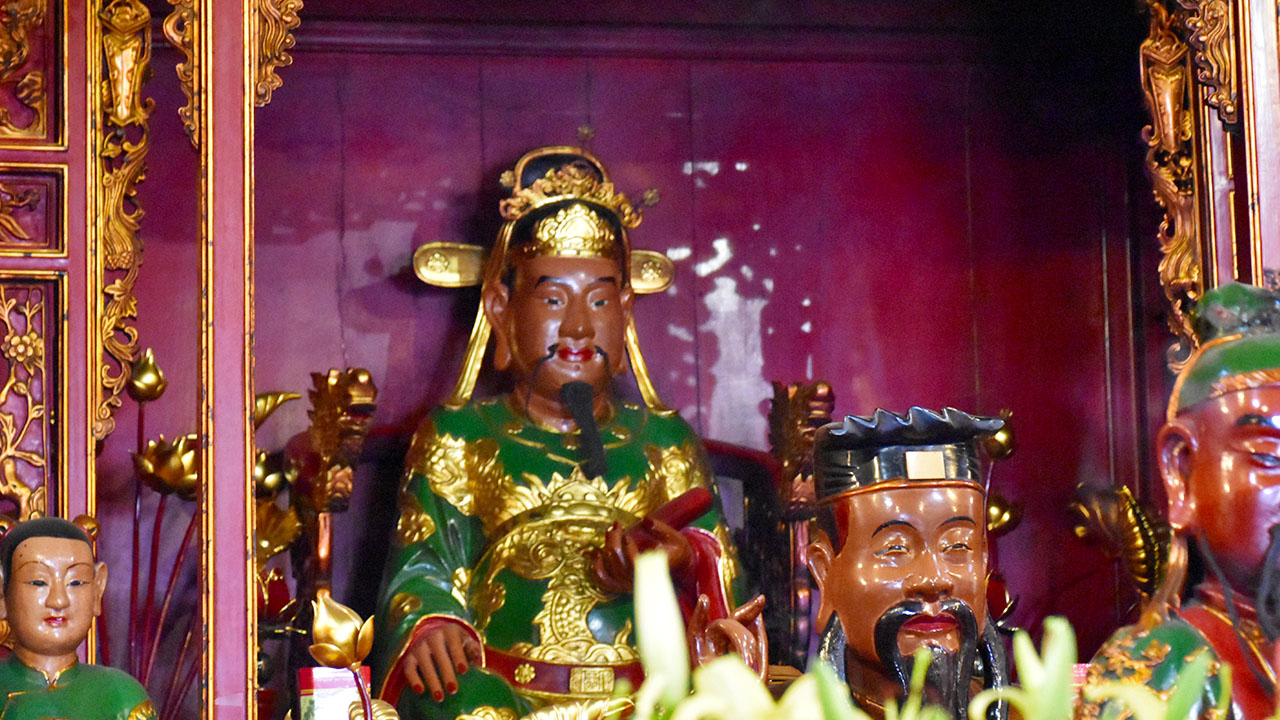
Another compelling narrative within Ngoc Son Temple is the worship of the ancient Three Sages. Initially, the temple was dedicated to Wenchang Dijun, Guan Yu, and Lü Dongbin. Each deity represents crucial virtues in Vietnamese culture: wealth and literary success (Wenchang Dijun), loyalty and martial prowess (Guan Yu), and wisdom and immortality (Lü Dongbin). Over time, the focus shifted to Trần Hưng Đạo, reflecting a cultural evolution towards venerating national heroes who symbolize real, historical triumphs and virtues over mythological figures.
The fusion of these legends within the temple’s spiritual atmosphere creates a space where history and mythology coexist, enriching the visitor’s experience. The architectural elements and ceremonial practices within the temple often reflect these stories, allowing visitors to immerse themselves in folklore as they explore the premises.
Architectural Features
Ngoc Son Temple’s unique architectural elements are integral to its allure, further amplifying the legends and historical anecdotes that resonate through its corridors. Each structure within the temple complex acts as a canvas, telling its own tale through intricate designs and symbolic motifs.
The Huc Bridge is one of the most iconic features, acting as the passageway to the temple and a metaphorical journey from the mundane to the divine. Painted in a vivid vermilion red, it’s symbolic of luck and prosperity, inviting visitors into a realm of spiritual reflection. Its design, blending Chinese and Vietnamese aesthetics, represents the harmonious confluence of those cultures, much like a well-composed symphony where each instrument contributes to the overall harmony.
Pen Tower (Tháp Bút) and Ink Slab (Đài Nghiên) stand as emblems of intellectual pursuit and literary excellence. The Pen Tower, with its sky-reaching feather pen design, signifies aspirations towards great scholarly achievements. The Ink Slab, stationed nearby, balances this ambition with grounded wisdom, creating a quintessential representation of the intellectual spirit of the Vietnamese people. These structures are not merely ornamental but enhance the temple’s narrative as a sanctuary for both martial and intellectual virtues.
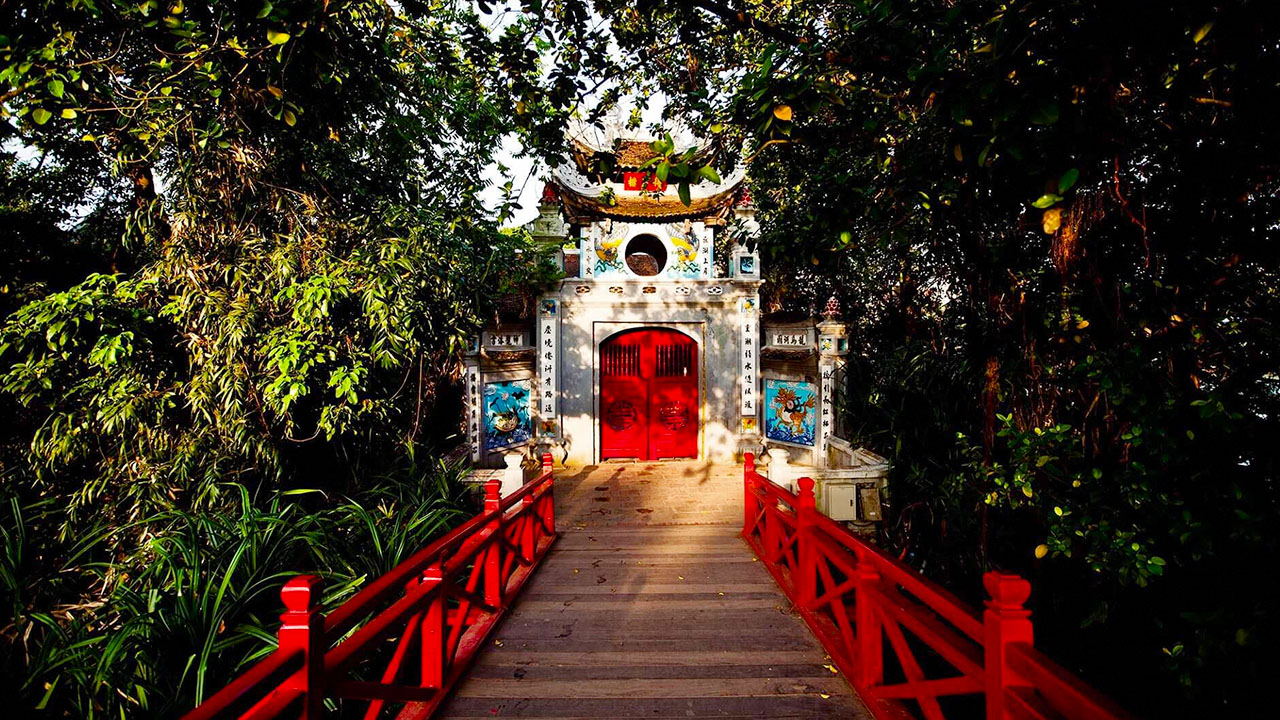
Pavilion Structures such as Tháp Bút, Đài Nghiên, Đắc Nguyệt, and Trấn Ba Đình contribute to the temple’s architectural grandeur. Each pavilion reflects traditional Vietnamese design elements, such as dual-layered roofs and dragon motifs, symbolizing harmony, balance, and protection against negative influences. These features mirror ancient Chinese architectural intricacies, symbolizing a deep-rooted cultural fusion.
Ngoc Son Temple’s architectural beauty, coupled with the legends and myths it harbors, creates an enriched historical experience. Visitors walking through the temple grounds can almost feel the presence of the legends, getting lost in a narrative tapestry that weaves together Vietnam’s past, present, and future.
Visitor Information
Understanding the practical details and guidelines surrounding a visit to Ngoc Son Temple is essential for ensuring a respectful and enriching experience. Below, you will find pertinent information on opening hours, entrance fees, the best times to visit, and guidelines on dress code and etiquette.
The exact address of Ngoc Son Temple is Đinh Tiên Hoàng, Hoàn Kiếm, Hanoi 100000, Vietnam.
Opening Hours and Entrance Fees
Planning a visit to Ngoc Son Temple involves understanding the operational logistics to make the most of your experience. The temple’s serene mornings and vibrant afternoons offer contrasting atmospheres that cater to different preferences.
Daily Operating Hours:
- Open: 8:00 AM to 5:00 PM daily, including weekends. Early morning visits are generally less crowded, providing a peaceful ambiance for personal reflection and exploration.
Entrance Fees:
- Standard Fee: The entrance fee for adults is 30,000 VND (approximately $1.30 USD), providing access to all areas within the temple grounds.
- Discounts:
- Children: Children under 15 years of age enter for free. Proof of age, such as an ID, may be required at the entrance gate.
- Payment: Tickets can be purchased directly at the entrance gate; no prior booking is required. Cash payment is preferred, and Vietnamese Dong is recommended for smoother transactions.
Best Times to Visit
To maximize the impact of your visit and avoid crowds, consider the following timeframes:
Ideal Visit Timing:
- Morning: Early morning hours from 8 AM to 10 AM are optimal for a peaceful experience, allowing uninterrupted exploration and introspection.
- Off-Peak Hours: Weekdays are generally less crowded compared to weekends, providing a quieter environment for discovering the temple’s intricacies.
Seasonal Considerations:
- Spring (March to May): Pleasant weather and blooming flora make this season ideal for a visit, enhancing the temple’s visual allure.
- Autumn (September to November): The cooler temperatures and picturesque foliage create a visually stunning backdrop for the temple complex.
- Avoid High Tourist Seasons: The temple can become crowded during major holidays and festivals. Opting for non-peak times ensures a more tranquil and immersive experience.
Dress Code and Visitor Etiquette
Maintaining a respectful demeanor and attire at Ngoc Son Temple is crucial, reflecting the sanctity and cultural significance of the site.
Modest Attire:
- Clothing: Visitors are expected to dress modestly. This includes attire that covers shoulders and knees. Light, breathable clothing is recommended due to Hanoi’s warm and humid climate, but it should maintain a respectful appearance.
- Footwear: It is customary to remove shoes before entering the main temple buildings. This practice respects the cultural and religious sanctity of the space.
Behavioral Etiquette:
- Respectful Conduct: Visitors should behave respectfully, speaking softly and avoiding disruptive actions. Being mindful of those who come to pray enhances the serene ambiance.
- Photography: While photography is generally allowed, visitors should refrain from photographing during worship sessions and avoid using flash. This consideration respects the spiritual practices of others.
- Preservation Awareness: Refrain from touching or damaging artifacts and historical structures. Observing and appreciating the temple’s artistry from a distance helps preserve its integrity.
- Follow Instructions: Adhering to guidelines provided by temple staff, such as prohibitions on certain areas, helps maintain the sanctity and preservation of the site.
Overall, Ngoc Son Temple offers a unique blend of spiritual and historical exploration. Respecting these guidelines ensures a meaningful and culturally enriched visit, allowing visitors to fully absorb the temple’s timeless beauty and heritage.
Nearby Attractions
The cultural and historical richness of the area surrounding Ngoc Son Temple is notable, as it is located centrally in Hanoi amidst numerous landmarks and attractions. Each of these nearby sites complements the experience of visiting Ngoc Son Temple, offering a deeper insight into Hanoi’s historical and cultural tapestry.
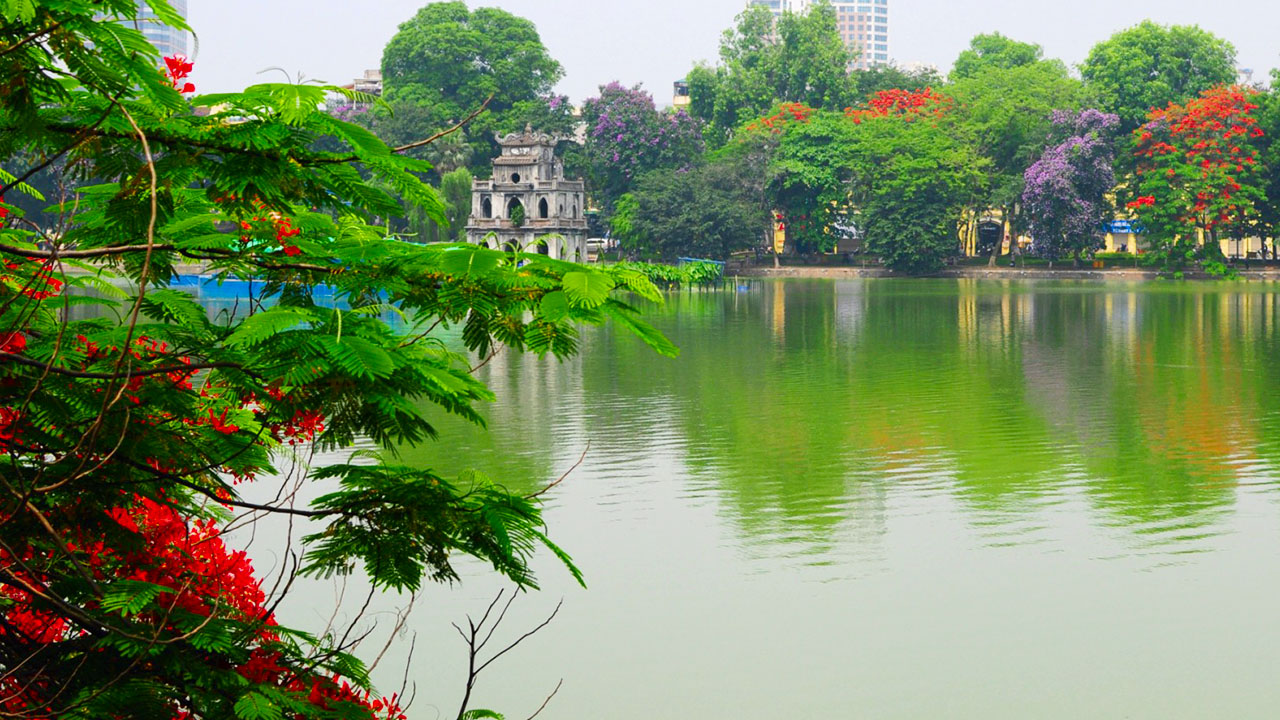
Hoan Kiem Lake
One of the most picturesque locations in Hanoi, Hoan Kiem Lake (Lake of the Restored Sword) serves as the setting for Ngoc Son Temple. The lake is not just a beautiful reservoir but a cultural center laden with historical significance and legends akin to the heart of the city. Encircling the lake are pathways that locals and tourists frequent for leisurely walks, morning exercises, and photography.
Key Features:
- Scenic Views: The lake’s serene waters reflect the city skyline, providing a perfect backdrop for photography. The sight is enchanting, particularly at dawn and dusk when the interplay of light creates a magical aura.
- Historic Significance: The lake plays host to the legendary Hoan Kiem Turtle and the story of the mystical sword, drawing tourists and locals alike to its mythic allure.
- Turtle Tower (Tháp Rùa): Standing on a small islet within the lake, this tower adds an element of mystique and serves as a favorite spot for quiet reflection and contemplation.
Other Notable Sites in Hanoi
Exploring Ngoc Son Temple’s vicinity provides access to various historically and culturally significant sites, enriching the overall experience of the area. Here are some key attractions:
- Thang Long Water Puppet Theater:
- Distance: Approximately 0.1 km from Ngoc Son Temple.
- Significance: This theater showcases traditional Vietnamese water puppetry, an art form dating back to the 11th century. Shows depict rural life, legends, and historical tales through engaging music and exquisite puppetry.
- Operating Hours: Daily performances from 3 PM to 8 PM, offering multiple showtimes.
- St. Joseph Cathedral:
- Distance: About 0.4 km from Ngoc Son Temple.
- Architecture: This neo-Gothic cathedral, inaugurated in 1886, stands as one of Hanoi’s oldest churches. It is reminiscent of medieval European cathedrals, with striking architectural features.
- Significance: The cathedral serves as a hub for Hanoi’s Catholic community and a center of religious and cultural activities.
- Hanoi Ancient House:
- Distance: Roughly 0.4 km from Ngoc Son Temple.
- Historical Insight: This structure offers a glimpse into traditional Vietnamese architecture and lifestyle. Visitors can explore the historical setup and gain insights into the cultural heritage of the old Hanoi.
- Ly Thai To Garden:
- Distance: Approximately 1 km from Ngoc Son Temple.
- Features: The garden houses a notable bronze statue of King Ly Thai To, the founder of Hanoi, and serves as a recreational space where locals engage in various activities.
- Significance: The garden is a communal space that reflects the lively spirit of the city.
- Bach Ma Temple:
- Distance: About 0.6 km from Ngoc Son Temple.
- Historical Value: This ancient temple, dedicated to the legendary white horse believed to have guided King Ly Thai To, is one of the oldest in Hanoi.
- Architectural Significance: The temple reflects the historical and mythological narratives that influence Hanoi’s cultural landscape.
By visiting these surrounding attractions, visitors not only gain deeper insights into Hanoi’s historical and cultural essence but also experience the city’s vibrant contemporary atmosphere. Each site offers a unique perspective, enhancing the overall appreciation of Hanoi’s rich and diverse heritage.
Ngoc Son Temple in Popular Culture
Ngoc Son Temple has transcended its position as a historical and religious site to become an indelible part of Vietnamese popular culture. Its prominent role in literature, film, and local narratives underscores its symbolic significance and cultural resonance.
Appearances in Literature and Film
Ngoc Son Temple’s depiction in literature and film serves to immortalize its cultural and historical significance, reinforcing its status as a profound emblem of Vietnamese identity and heritage.
Literary Significance:
- Historical Narratives: The temple frequently appears in Vietnamese literature, symbolizing the enduring spirit and cultural memory of the nation. Writers often reference Ngoc Son Temple to invoke themes of heroism, national pride, and spirituality. Much like the famed Notre-Dame Cathedral in Victor Hugo’s “The Hunchback of Notre-Dame,” Ngoc Son Temple in Vietnamese literature often embodies the soul of the nation.
- Folklore and Legends: The temple’s legends, such as the story of the Hoan Kiem Turtle and the mystical sword, are often depicted in literary works, providing cultural continuity and moral lessons through generations. These narratives serve as allegories for triumph, unity, and divine favor, enriching the cultural fabric of Vietnamese storytelling.
Film Representation:
- Cinematic Backdrop: Ngoc Son Temple’s picturesque setting makes it a favored location for filmmakers. It has been prominently featured in Vietnamese films, where its serene environment and historical richness add depth to the narrative. The use of Ngoc Son Temple in films often highlights themes of reflection, spiritual quest, and cultural pride, enriching the visual storytelling of Vietnamese cinema.
- Symbolic Presence: Films often depict Ngoc Son Temple not merely as a physical space but as a symbol of Vietnamese resilience and identity. Its appearance in various cinematic works acts as a visual shorthand for national heritage and cultural values, much like the Eiffel Tower signifies Paris or the Statue of Liberty symbolizes the United States.
Representation of Traditional Vietnamese Values
Ngoc Son Temple stands as a symbol of Vietnam’s core traditional values, encapsulating elements such as spirituality, intellectual pursuit, and cultural pride.
Spiritual Significance:
- Religious Reverence: The temple’s dedication to deities like Trần Hưng Đạo and Văn Xương Đế Quân reflects the deep spiritual reverence embedded in Vietnamese culture. Visitors engage in rituals and prayers that honor these figures, maintaining a connection to the nation’s historical and spiritual roots.
- Cultural Continuity: The legends associated with the temple, particularly those involving divine intervention and heroic deeds, continue to resonate within Vietnamese society, reflecting an enduring belief in spiritual protection and guidance.
Intellectual and Cultural Values:
- Scholarly Pursuits: The Pen Tower and Ink Slab symbolize the importance of education and intellectual achievement, values that are deeply ingrained in Vietnamese culture. The temple stands as a testament to the nation’s respect for knowledge, literature, and artistic expression.
- National Identity: By celebrating historical heroes and integrating folklore into its narrative, Ngoc Son Temple reinforces a sense of national identity and cultural pride. It acts as a physical and symbolic reminder of Vietnam’s historical legacy and the values upheld by its people.
In essence, Ngoc Son Temple’s presence in popular culture, be it through literature, film, or local legends, highlights its role as a cultural keystone. It embodies Vietnam’s traditional values, spiritual depth, and historical memory, continuing to captivate and inspire. The temple’s ability to transcend time and narrative forms positions it not just as a historical site, but as an enduring symbol of Vietnamese culture and identity.
Conclusion
Ngoc Son Temple is more than a historical relic; it is a living, breathing testament to Vietnam’s rich cultural heritage and spiritual history. Nestled on Jade Island in the heart of Hoan Kiem Lake, its serene environment and intricate architecture offer visitors a profound glimpse into the soul of Vietnamese culture. As we’ve explored, the temple’s significance is manifold, encapsulating historical reverence, architectural elegance, and cultural narratives that span centuries.
The temple’s history is a fascinating journey through time, marked by periods of construction and renovation that have imbued it with lasting beauty and significance. Legendary tales like that of the Hoan Kiem Turtle and the magical sword, coupled with the veneration of historical figures such as General Trần Hưng Đạo and the literary deity Van Xuong De Quan, add rich layers of meaning to the temple. These narratives not only emphasize the temple’s historical essence but also its role as a symbol of Vietnamese unity, resilience, and intellectual pursuit.
Architecturally, Ngoc Son Temple stands as a beacon of Vietnamese craftsmanship. The vibrant Huc Bridge, the iconic Pen Tower and Ink Slab, and the array of pavilions within the temple complex each tell their own story, creating an environment that is both artistically striking and spiritually inviting. Visitors can immerse themselves in a tranquil journey from the bustling streets of Hanoi to a serene sanctuary that melds natural beauty with human ingenuity.
Culturally, the temple plays a pivotal role. It is a custodian of traditional Vietnamese values, emphasizing the importance of spirituality, education, and national pride. Its depiction in literature and film underscores its symbolic significance, making it a cultural icon that transcends its physical form. The temple’s presence in Vietnamese folklore and popular culture further cements its status as a keystone of the nation’s collective memory and identity.
For visitors planning a trip to Ngoc Son Temple, practical information about opening hours, entrance fees, and visitor etiquette enhances the experience by ensuring cultural respect and awareness. With its ideal location amidst Hanoi’s rich tapestry of historical sites and attractions, the temple offers not just a visit, but an immersive cultural journey.
In conclusion, Ngoc Son Temple is a treasure trove of history, culture, and spirituality. It stands as a symbol of Vietnam’s enduring legacy, offering insights into the nation’s past and present while inspiring future generations. A visit to Ngoc Son Temple is not merely a sightseeing activity but an intimate encounter with the very essence of Vietnamese heritage, making it a must-visit destination for anyone seeking to understand and appreciate the depth and beauty of Vietnam.


